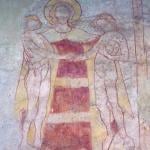BRIDEGROOMS, CHICK PRIESTS, METAPHORS… AND ISTANBUL!: First, go read Emily Stimpson on why chicks can’t be priests–here and then (in response to me) here and here.
(She’s also got yet more on priestly celibacy, here .)
Then, check out these interesting emails from reader John W. Brewer: “Dear Eve, Don’t get yourself hung up by trying to play out all possible implications of the bridegroom/bride image. Scripture and tradition have lots of metaphors which are all true (or convey truth) in the way that metaphors are (or do), and maybe even a bit more than an ordinary human poetic metaphor would. It is easy, however, to purport to demonstrate contradictions or problems if you jam them all together. Let’s see: the Church is our Mother; Christ is our Brother; so our brother is our mother’s husband . . . hey, wait! (Making Christ our stepbrother, which is probably a more precise way of capturing a lot of the relevant NT passages from Paul, simply makes the Christian family seem kind of like Woody
and Soon-Yi, which is not really much of an improvement.) Here’s another one: take one of those Homeric catalogs of epithets applied by certain pious traditions to Mary and try to combine them. What would it look like for a Throne of Wisdom to imultaneously be a Star of the Sea and a Mirror of Charity? Something Ezekiel would see on a bad trip, I think. All this shows is that these images/metaphors are not intended to be propositions that can be assembled into a single coherent system of formal logic and manipulated as such, which just shows that formal logical system-building is not the only useful way to convey truth.”
[Right; I only find that the metaphors clash and tangle when people try to build arguments off of them when there are conflicting arguments to be built off of other metaphors.]
“By the way, I’ve never found the image-of-Christ line of argument for a male presbyterate particularly compelling myself, but I think that’s in part because it seems (tho I could be wrong because I haven’t read the stuff thoroughly or closely) that it’s part of a larger argument that assumes as a starting point a very specific and detailed understanding of the presbyterate which is distinctively Roman Catholic and which I do not entirely share. I’m therefore not all that interested in whether the conclusion necessarily follows from the premises since I’m not sure I’ve accepted the premises. (There’s also a broader problem. One often wants to come up with an after-the-fact logical rationale for tradition, since blind obedience to tradition seems so unsatisfying. However, particular rationales advanced very often seem less than compelling, and unable to account persuasively for the implicit wisdom contained in the tradition. See Hayek blah blah blah. I think Roman Catholic theology sometimes risks binding the validity of a very robust tradition to a fairly brittle post hoc philosophical defense of it, with the result that the vitality of the tradition may be undermined.)”
[I agree with this assessment of the danger of post-hoc philosophizing, but I find that if you give the think-folk enough time, they eventually come up with a startling, very cool, allusive, and helpful understanding of the tradition at issue, after a few centuries of dead ends….]
“The other contextual/historical point about women priests is that the ancient Mediterranean was packed with pagan cults with female clergy serving in societies that did not, to put it mildly, have a particularly modern feminist or egalitarian view of the role of women generally, which makes attributing the omission to background cultural patriarchal bias unconvincing. (I guess there may be some people who think classical Athens was more chick-friendly than Second Temple Israel, but I think they’re just provably empirically wrong.)”
And if you want more Brewerly goodness, check out this email he sent Unqualified Offerings on the history of Istanbul (and Constantinople).











